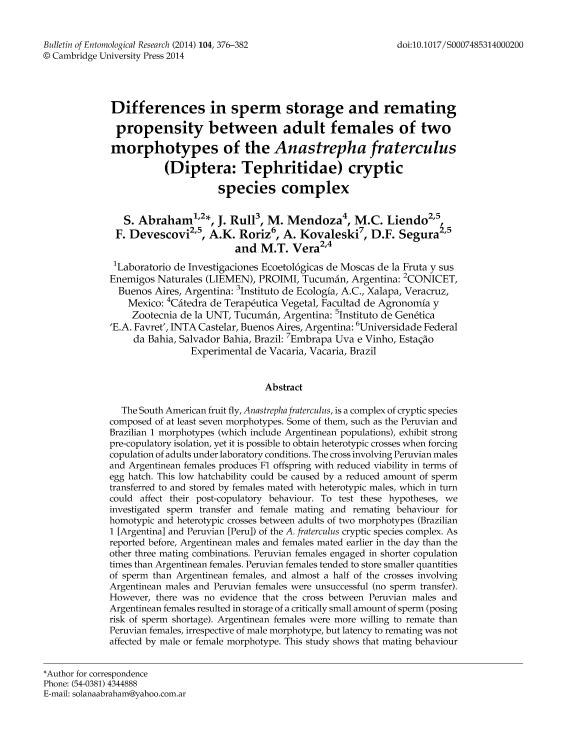Artículo
Differences in sperm storage and remating propensity between adult females of two morphotypes of the Anastrepha fraterculus (Diptera: Tephritidae) cryptic species complex
Abraham, Solana ; Rull Gabayet, Juan Antonio
; Rull Gabayet, Juan Antonio ; Mendoza, M.; Liendo, María Clara
; Mendoza, M.; Liendo, María Clara ; Devescovi, Francisco
; Devescovi, Francisco ; Roriz, A. K.; Kovaleski, A.; Segura, Diego Fernando
; Roriz, A. K.; Kovaleski, A.; Segura, Diego Fernando ; Vera, Maria Teresa
; Vera, Maria Teresa
 ; Rull Gabayet, Juan Antonio
; Rull Gabayet, Juan Antonio ; Mendoza, M.; Liendo, María Clara
; Mendoza, M.; Liendo, María Clara ; Devescovi, Francisco
; Devescovi, Francisco ; Roriz, A. K.; Kovaleski, A.; Segura, Diego Fernando
; Roriz, A. K.; Kovaleski, A.; Segura, Diego Fernando ; Vera, Maria Teresa
; Vera, Maria Teresa
Fecha de publicación:
04/2014
Editorial:
Cambridge University Press
Revista:
Bulletin Of Entomological Research
ISSN:
0007-4853
e-ISSN:
1475-2670
Idioma:
Inglés
Tipo de recurso:
Artículo publicado
Clasificación temática:
Resumen
The South American fruit fly, Anastrepha fraterculus, is a complex of cryptic species composed of at least seven morphotypes. Some of them, such as the Peruvian and Brazilian 1 morphotypes (which include Argentinean populations), exhibit strong pre-copulatory isolation, yet it is possible to obtain heterotypic crosses when forcing copulation of adults under laboratory conditions. The cross involving Peruvian males and Argentinean females produces F1 offspring with reduced viability in terms of egg hatch. This low hatchability could be caused by a reduced amount of sperm transferred to and stored by females mated with heterotypic males, which in turn could affect their post-copulatory behaviour. To test these hypotheses, we investigated sperm transfer and female mating and remating behaviour for homotypic and heterotypic crosses between adults of two morphotypes (Brazilian 1 [Argentina] and Peruvian [Peru]) of the A. fraterculus cryptic species complex. As reported before, Argentinean males and females mated earlier in the day than the other three mating combinations. Peruvian females engaged in shorter copulation times than Argentinean females. Peruvian females tended to store smaller quantities of sperm than Argentinean females, and almost a half of the crosses involving Argentinean males and Peruvian females were unsuccessful (no sperm transfer). However, there was no evidence that the cross between Peruvian males and Argentinean females resulted in storage of a critically small amount of sperm (posing risk of sperm shortage). Argentinean females were more willing to remate than Peruvian females, irrespective of male morphotype, but latency to remating was not affected by male or female morphotype. This study shows that mating behaviour differs between some of the A. fraterculus complex morphotypes, with female but not male morphotype determining female likelihood to remate.
Archivos asociados
Licencia
Identificadores
Colecciones
Articulos(CCT - NOA SUR)
Articulos de CTRO.CIENTIFICO TECNOL.CONICET - NOA SUR
Articulos de CTRO.CIENTIFICO TECNOL.CONICET - NOA SUR
Citación
Abraham, Solana; Rull Gabayet, Juan Antonio; Mendoza, M.; Liendo, María Clara; Devescovi, Francisco; et al.; Differences in sperm storage and remating propensity between adult females of two morphotypes of the Anastrepha fraterculus (Diptera: Tephritidae) cryptic species complex; Cambridge University Press; Bulletin Of Entomological Research; 104; 3; 4-2014; 376-382
Compartir
Altmétricas



